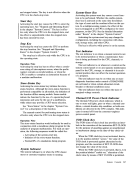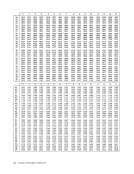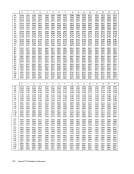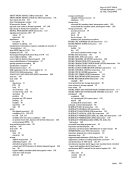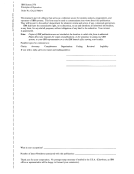Appendix B. Functions That Differ from System/360
This appendix summarizes the areas whereSystem/370 differs from System/360. Not included
areSystem/370 functions, such as block mUltiplex
ing, which are suppressed on initialization, and newSystem/370 functions, such as new instructions,
which are specified in such a manner that they cause
program exceptions onSystem/360. Removal of USASCII-8 Mode System/360 provides for USASCII-8 by a mode
under control ofPSW bit 12. USASCII-8 was a pro
posed zoned-decimal code that has since been re
jected. When bit 12 of theSystem/360 PSW is one,
the codes preferred for theUSASCII-8 are generat
ed for decimal results. WhenPSW bit 12 is zero, the
codes preferred for EBCDIC are generated.
InSystem/370, the USASCII-8 mode and the
associated meaning ofPSW bit 12 are removed. In System/370, all instructions whose execution in System/360 depends on the setting of PSW bit 12
are executed generating the code preferred for
EBCDIC.
Bit 12 of thePSW is handled in System/370 as
follows:• In models that do not have the extended-control
(EC) mode installed, a one inPSW bit position
12 causes a program interruption for specifica
tion exception.• In models that have the EC mode installed, a
one inPSW bit position 12 causes the CPU to
operate in the EC mode.
Handling Invalid DecimalSign In System/360, an invalid decimal operand causes
the operation to be terminated. InSystem/370 the
operation is suppressed, instead of terminated, when
an invalid sign is detected. The action applies to all
instructions that check the validity of decimal ope
rands: ADD DECIMAL,SUBTRACT DECIMAL,
ZERO AND ADD,COMPARE DECIMAL, MUL TIPL Y DECIMAL, DIVIDE DECIMAL, and
CONVERTTO BINARY. It includes also the System/370 instruction SHIFT AND ROUND DEC
IMAL.
Recognizing Protection Exception in
Edit
InSystem/360, when a pattern character in an
EDIT or EDIT AND MARK operation is fetched
from a location protected against storing but remains
unchanged in the operation; it depends on the model
whether or not the protection exception is recognized.
InSystem/ 3 7 0, the protection exception in the above
case is recognized.
Operation Code for HALT DEVICE
InSystem/370, the first eight bits of the operation
code assigned to HALT DEVICE are the same as
those assigned to HALT I/O, the distinction be
tween the two instructions being specified by bit
position 15. InSystem/360, bit position 15 is ig
nored, and HALTI/O is performed in both cases.
Extent of Logout Area
In System/360, the logout area starts with location
128 and extends through as many locations as the
given model requires. Portions of this area are used
for machine-check logout, and other portions may
be used for channel logout. While no limit is set on
the size of the logout area, the extent of the area
used on most System/360 models is less than that
stored by a comparable System/370 model.On System/370, the machine-check interruption
causes information to be stored at locations 216-
239, 248-255, and 352-51l. Additionally, the mod
el may store logout information in the fixed logout
area, locations 256-351, and the model may also
have a machine-check extended logout (MCEL),
which, on initialization, is specified to start at loca
tion 512. Channels may place logout information in
the limited channel logout area, locations 176-179,
and in the fixed logout area, locations 256-35l.
Command RetrySystem/370 channels may provide command retry,
whereby the channel, in response to a signal from
the device, can retry the execution of a channel com
mand.Since I/O devices announced prior to System/370 do not signal for command retry, no
problem of compatibility exists on these devices.
However, some new devices, which would otherwise
be compatible with former devices, do signal for
command retry.
The occurrence of command retry will usually
have no significant effect on the result produced by
a channelprogram; however, the following is a list
of some of the effects of command retry:
Appendix B. Functions That Differ fromSystem/360 251
This appendix summarizes the areas where
are
ing, which are suppressed on initialization, and new
which are specified in such a manner that they cause
program exceptions on
under control of
posed zoned-decimal code that has since been re
jected. When bit 12 of the
the codes preferred for the
ed for decimal results. When
codes preferred for EBCDIC are generated.
In
associated meaning of
are executed generating the code preferred for
EBCDIC.
Bit 12 of the
follows:
(EC) mode installed, a one in
12 causes a program interruption for specifica
tion exception.
one in
operate in the EC mode.
Handling Invalid Decimal
the operation to be terminated. In
operation is suppressed, instead of terminated, when
an invalid sign is detected. The action applies to all
instructions that check the validity of decimal ope
rands: ADD DECIMAL,
ZERO AND ADD,
CONVERT
IMAL.
Recognizing Protection Exception in
Edit
In
EDIT or EDIT AND MARK operation is fetched
from a location protected against storing but remains
unchanged in the operation; it depends on the model
whether or not the protection exception is recognized.
In
case is recognized.
Operation Code for HALT DEVICE
In
code assigned to HALT DEVICE are the same as
those assigned to HALT I/O, the distinction be
tween the two instructions being specified by bit
position 15. In
nored, and HALT
Extent of Logout Area
In System/360, the logout area starts with location
128 and extends through as many locations as the
given model requires. Portions of this area are used
for machine-check logout, and other portions may
be used for channel logout. While no limit is set on
the size of the logout area, the extent of the area
used on most System/360 models is less than that
stored by a comparable System/370 model.
causes information to be stored at locations 216-
239, 248-255, and 352-51l. Additionally, the mod
el may store logout information in the fixed logout
area, locations 256-351, and the model may also
have a machine-check extended logout (MCEL),
which, on initialization, is specified to start at loca
tion 512. Channels may place logout information in
the limited channel logout area, locations 176-179,
and in the fixed logout area, locations 256-35l.
Command Retry
whereby the channel, in response to a signal from
the device, can retry the execution of a channel com
mand.
problem of compatibility exists on these devices.
However, some new devices, which would otherwise
be compatible with former devices, do signal for
command retry.
The occurrence of command retry will usually
have no significant effect on the result produced by
a channel
of some of the effects of command retry:
Appendix B. Functions That Differ from
























































































































































































































































